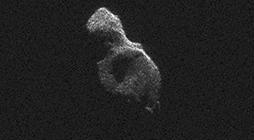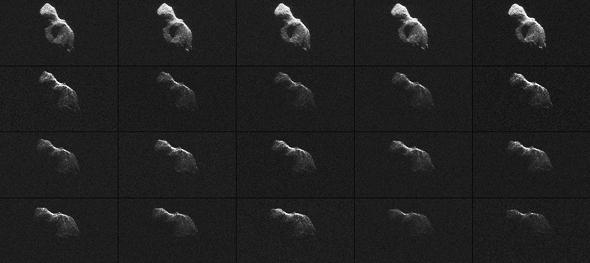2014 HQ124 is an asteroid that was discovered in April 2014 and was quickly determined to be a near-Earth asteroid, one whose orbit brings it pretty close to our fair world.
On June 8, it passed a mere 1.4 million kilometers (900,000 miles) from us. That’s pretty far in human terms—more than three times farther away than the Moon—but on a cosmic scale that’s a close shave. Even that close, a typical asteroid is still too far to resolve (that is, see it as more than just a dot) with optical telescopes … but not to radio telescopes.
Combining the power of the Goldstone 70 meter dish with the Arecibo 300 meter ‘scope, astronomers pinged HQ124 with pulses of radar, creating some of the highest-resolution images of a near-Earth rock ever obtained. They combined them into a pretty nifty animation, too:
Mind you, what you’re seeing there is not an image in the way we normally think of them. The radar pulses are sent to the asteroid, where they bounce off the surface and are reflected back to Earth. By timing the pulses and measuring their wavelength very carefully, the shape and rotation rate of the asteroid can be determined. I have a much more detailed explanation in a post about another asteroid undergoing this treatment, and Emily Lakdawalla has the technical info on how this works.

Photo by NASA/JPL-Caltech/Arecibo Observatory/USRA/NSF
The observations show HQ124 to be an elongated rock about 400 meters (1,300 feet) across, and about half that in width. Many asteroids have this sort of shape, and it may be because they’ve been battered and sculpted by impacts over the eons, or it may be because it’s what’s called a contact binary; two asteroids that came into contact and stuck together. Quite a few like this are known, and even some comets, too.
You can see that HQ124 isn’t smooth, either. There are craters and hills on it, meaning it’s suffered the slings and arrows of impacts over time. Every asteroid we’ve seen up close is like this; which isn’t terribly surprising. While space is big, and objects few and far between, there are billions of small rocks out there. Given billions of years, well, the odd encounter or thousand is inevitable.
Asteroids are leftover bits from the formation of the solar system. Planets and moons have changed a lot since that time—just the process of growing to be big changes the chemical composition of the material of a planet. Asteroids have changed too, but not nearly as much, and studying them gives us a pretty nice window into what things were like 4.5 billion years ago when the solar system was young. Space probes give us the best view of asteroids, of course, but they’re expensive and we don’t have too many just yet. Radar observations of asteroids that pass us by give us fantastic opportunities to peer at these time capsules, and help us understand the birth and evolution of our cosmic neighborhood.
And because why not:

This picture is a meme all over the Internet, and I couldn’t find a source. If you know who originally made it, please let me know! They deserve credit.
